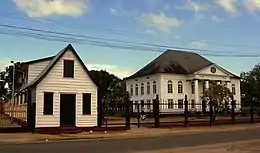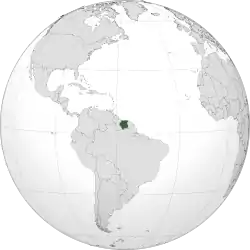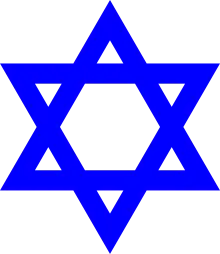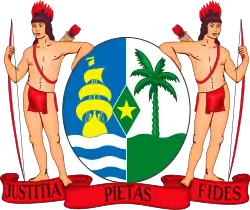History of the Jews in Suriname
The history of the Jews in Suriname starts at least in the 17th century, when in 1639, the English government allowed Spanish and Portuguese Jews from the Netherlands, Portugal and Italy to settle the region, coming to the old capital Torarica. In 1652, a new group that migrated under the leadership of Francis Willoughby, 5th Baron Willoughby of Parham came to Suriname [1] and settled in the Jodensavanne area. A third group came 1664, after their expulsion from Recife and then French Guiana, led by David Cohen Nassy.[2] According to the Encyclopedia of Latin America, "Suriname was one of the most important centers of the Jewish population in the Western Hemisphere, and Jews there were planters and slaveholders."[3]


| Part of a series on |
| Jews and Judaism |
|---|
 |
|
Part of a series on the |
|---|
| History of Suriname |
 |
|
|
The plantation economy of the Jodensavanne—an area of savannah that was settled and planted with sugarcane—relied on slave labour. The community declined in the wake of the French Cassard expedition in 1712 and the levies he instituted, competition from beet sugar, and attacks by Maroons -slaves which had managed to escape from the plantations into the jungle, integrated with local Native American tribes, and now raided the holdings of their former masters as free men. The Jews eventually relocated to the capital of Paramaribo, but they would return to the synagogue in the Jodensavanne to celebrate the holidays until 10 September 1832, when a fire destroyed the village and synagogue. The savanna area was subsequently overtaken with jungle regrowth.[4]
History
Jews in Suriname were initially split into the more populous Sephardim concentrated in the Jewish Savanna, and the much later arriving and less numerous Ashkenazim at the Neve Salom synagogue (the only still functioning synagogue). After the plantation economy failed and the Jewish Savanna depopulated, most inhabitants moved to Paramaribo, here the white Jews found it increasingly difficult not to integrate with other ethnic groups of the country, despite periodic attempts from Jewish leaders in the Netherlands to keep them in line -many simply intermarried with other ethnicities in the 19th century. in 1825 Jewish people in Suriname were given equal rights, this also caused them to loose their privileges which allowed them to police their own community. Also the two original Jewish groups began to blur together by the 18th century, even sharing a synagogue for a while. The two groups officially fused in 1999. In 2004 the last remaining synagogue decided to switch from Orthodox Judaism to Progressive Judaism.[5]
Although today the term Creole (as used in the context of Suriname) is the word used locally for 'Afro-Surinamese' (people or culture), its original meaning carried a negative connotation to mean that a white European person had forgotten how to be a "good Jew" (or proper Englishman, etc.) due to having adopted some characteristics that European communities considered "native".[6]
Especially Sephardic Jewish men 'interacted' with the black slaves on their plantations, and the usually illegitimate children with African women were raised as Jews and given Jewish names. By the 18th century this black and coloured population had grown considerably. Black and coloured Jews were not considered 'real' Jews by the white Jews, the first rules which formally classified these 'mulatos' as not being jechidim were formulated by the Beracha Ve Shalom synagogue in 1754. Coloured Jews were allowed inside the synagogues, but were not allowed to participate in any of the rituals, and had to sit on special pews which were lower than the others. Eventually the coloured Jews formed their own synagogue: Darje Jesariem or Darhe Jesarim in 1791, although the white Jews considered this legally more of a fraternity -it only lasted until 1794. The building has long been destroyed (in 1804), but in its place is a city square known as Sivaplein, siva meaning 'fraternity' in the language of the Portuguese Jews. In 1841 black and coloured Jews were given equal religious rights in Suriname.[5][7]
Some Jewish family names have endured and are now considered Afro-Surinamese family names and the names of the Saramaka clan of Maroons refer to the Jewish plantation owners their ancestors escaped from. In the cemeteries of Paramaribo Jewish tombstones appear alongside creole ones.[6]
Identity can be used to exclude persons from a community, but it can also be used to force people to be part of community against their will. During the 17th and 18th centuries forced inclusion was commonplace in both the Portuguese and High German Jewish communities and the rigid identity boundaries were often supported by legislation. Though the cultural identity of Portuguese Jews was defined as being a white colonial elite, this identity existed alongside an aggressive policy to include poor and Jews of color.[6]
Synagogues
Three official synagogues were built in Suriname: Beracha Ve Shalom in 1685, in the Jodensavanne; Neveh Shalom Synagogue in 1719, built by Ashkenazi Jews in the new capital of Paramaribo; and Zedek ve Shalom in 1735, built by Sephardic Jews.[4]
Depopulation
Most Jews left Suriname when it was granted independence in 1975 and others left during the civil war of the 1980s.[4] About 130 Jewish community members remained in a combined Sephardic and Ashkenazic congregation at Neve Shalom (which includes community hall and mikveh). The second synagogue was rented for use as a computer service shop, its furniture and art loaned to the Israel Museum in Jerusalem.
In the 1990s, the jungle growth in the Jodensavanne was cleared, 450 graves uncovered and the ruins of the synagogue maintained.[4] In a 21st-century census, 181 entered "Judaism" as their religion, out of a total population of 560,000.[8]
See also
References
- Francis, Lord Willoughby
- Herschthal, Eric (17 August 2006). "A Star Historian Opens a New Chapter". The Jewish Daily Forward. Retrieved 29 November 2011.
- Encyclopedia of Latin America: Amerindians through The Age of Globalization (Prehistory to the Present). J. Michael Francis, Facts On File. New York, N.Y. 2010, p. 296,
- The Surprising Discovery of Suriname’s Jewish Community by Jacob Steinberg, 2008 Kulanu
- Cohen, Julie-Marthe (2019). "Joden in de Cariben" (in Dutch). Joods Cultureel Kwartier. Retrieved 5 October 2020.
- Vink, W., 2010. Creole Jews: negotiating community in colonial Suriname. BRILL.
- Jewish Sanctuary in the Atlantic World: A Social and Architectural History by Barry L. Stiefel
- "Definitieve Resultaten Achtste Algemene Volkstelling" (PDF). ALGEMEEN BUREAU VOOR DE STATISTIEK - SURINAME. Archived from the original (PDF) on 2015-09-24.
External links
- Haruth.com – "Jews in Suriname"